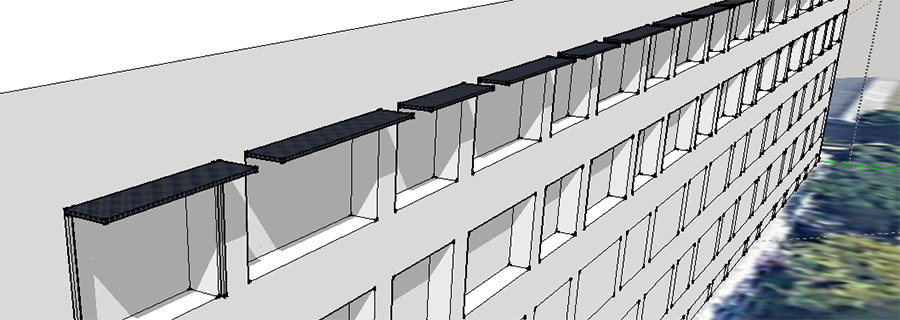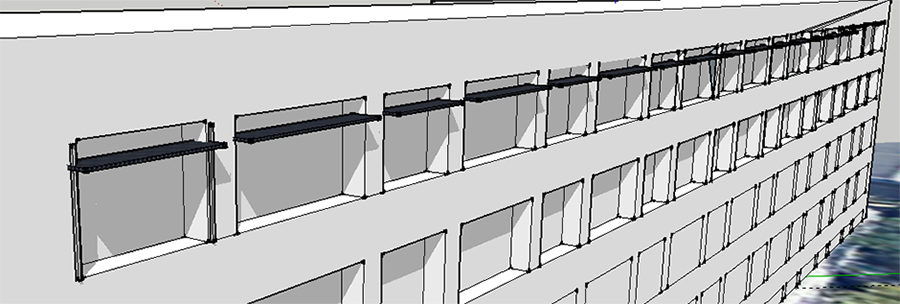Photovoltaic brise soleil
Brise soleil are a relatively common installation solutions for building window facing directly sunward. A bris soleil is normally directly above a window opening and protrude out a certain distance. This distance prevents higher summer sunshine directly hitting the window, causing over heating, but allows the lower winter sunlight through into the window.
Photovoltaic brise soleil work on the same principle, but because the shade is made of a photovoltaic panel, the higher summer sun generates electricity as it deflects the sunshine from the window. These kinds of brise soleil are less common but offer the same external shading which can be fitted over the entire exterior of a building or solely over the problematic window, whilst also contributing to renewable electricity generation electrical power. The types of panels used can vary significantly from solid panels, to individual cells on glass or translucent cells.
Key aspects in the design of photovoltaic brise soleil are consideration of the orientation, overshadowing and safety in maintenance. The southern sides of buildings typically require horizontal brise soleil above the window opening to block the high summer sun.
It is also possible to consider a light shelf type of installation which is installed part way down a window, normally at the transom, where there is a low level large glazed unit and a higher level strip opening unit. This kind of installation blocks some sun to the main glazed ares in summer, particularly at desk level, but it is traditionally also light on its upper surface to reflect light onto the ceiling of the inside space. In teh case of a PV brise soleil, the internal edge may be reflective, but the body of the shade will be darker PV though glossy with some reflectional capabilities.
For the east and west facing sides of a building vertical shading elements might be introduced, though these need to be modelled both in terms of shading ability and electrical production. be used, to follow the sun and actively control the solar gain of the building. This allows optimum protection at the appropriate time of day and year.
[edit] Related articles on Designing Buildings
- Albedo.
- Approved Document O.
- Better prediction of overheating in new homes.
- Comfort in low energy buildings.
- Design summer year (DSY)
- Evolving opportunities for providing thermal comfort.
- Future climate models.
- Good homes alliance overheating tool
- Heat stress.
- Heatwave.
- Human comfort in buildings.
- Low-e glass.
- Maximum and minimum workplace temperatures.
- Natural light.
- Overheating - assessment protocol.
- Overheating in buildings.
- Overheating in residential properties.
- Passive building design.
- Photovoltaics.
- Preventing overheating.
- Retrofitting solar shading.
- Solar gain.
- Solar shading.
- Solar shading of buildings BR 364.
- Solar thermal panels.
- Temperature.
- Thermal comfort.
- Thermal indices.
- Thermal pleasure in the built environment.
- Trombe wall.
- Urban heat island effect.
- Urban heat island.
Featured articles and news
Welsh Skills Body (Medr) launches ambitious plan
The new skills body brings together funding and regulation of tertiary education and research for the devolved nation.
Paul Gandy FCIOB announced as next CIOB President
Former Tilbury Douglas CEO takes helm.
UK Infrastructure: A 10 Year Strategy. In brief with reactions
With the National Infrastructure and Service Transformation Authority (NISTA).
Ebenezer Howard: inventor of the garden city. Book review.
The Grenfell Tower fire, eight years on
A time to pause and reflect as Dubai tower block fire reported just before anniversary.
Airtightness Topic Guide BSRIA TG 27/2025
Explaining the basics of airtightness, what it is, why it's important, when it's required and how it's carried out.
Construction contract awards hit lowest point of 2025
Plummeting for second consecutive month, intensifying concerns for housing and infrastructure goals.
Understanding Mental Health in the Built Environment 2025
Examining the state of mental health in construction, shedding light on levels of stress, anxiety and depression.
The benefits of engaging with insulation manufacturers
When considering ground floor constructions.
Lighting Industry endorses Blueprint for Electrification
The Lighting Industry Association fully supports the ECA Blueprint as a timely, urgent call to action.
BSRIA Sentinel Clerk of Works Training Case Study
Strengthening expertise to enhance service delivery with integrated cutting-edge industry knowledge.
Impact report from the Supply Chain Sustainability School
Free sustainability skills, training and support delivered to thousands of UK companies to help cut carbon.
The Building Safety Forum at the Installershow 2025
With speakers confirmed for 24 June as part of Building Safety Week.
The UK’s largest air pollution campaign.
Future Homes Standard, now includes solar, but what else?
Will the new standard, due to in the Autumn, go far enough in terms of performance ?
BSRIA Briefing: Cleaner Air, Better tomorrow
A look back at issues relating to inside and outside air quality, discussed during the BSRIA briefing in 2023.
Restoring Abbotsford's hothouse
Bringing the writer Walter Scott's garden to life.
Reflections on the spending review with CIAT.


























